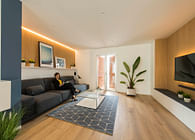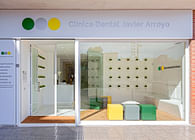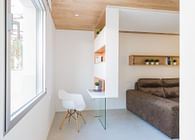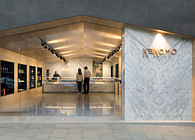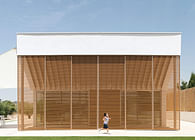
Petrel, ES
The starting point for converting an industrial building into the new headquarters of the Ginebre Restaurant was to analyse its menu. And if Mediterranean gastronomy marks the carte of the place, the architecture had to correspond to it in the space. The reactivation of an old industrial building situated in the industrial estate of the town of Petrer, begins with two ceramic-bricks cantilevers whose curvature invites one to enter the restaurant, or to go around the building to directly access the lounge in the lower floor.
The upper part of the façade is finished off with a square lattice of white concrete, which subtly and elegantly emphasises the shape of the curved brickwork. The characteristic reddish colour is accompanied by large wooden folding doors that frame the main entrance and the access to the gourmet shop.
Its display shelves and wine cellars, designed in an old-fashioned way, are assembled by ceramic pieces such as bards. The flooring throughout the interior combines the warmth of its cream colour, enhancing the contrast of the traditional green-glazed ceramics of the new restaurant bars and counters.
The lower lounge, on the semi-basement level, is reminiscent of a wine cellar. Its gently sloping brick vaulted ceilings contribute to accentuate the feeling of seclusion. These backlit curves give a powerful characteristic image to the new Ginebre restaurant. The fabric-covered walls not only recall crafts such as raffia and straw, but also serve as an acoustic solution to provide a comfortable atmosphere in the dining room by absorbing sound. From the living room itself, you can enjoy views towards the kitchen to enjoy the traditional process of cooking rice over a wood fire. You can also enjoy views of the back courtyard, which is also equipped for service.
Ceramic brick stands out among all the natural materials in the project. It has its origins in the soil of the surrounding area, with the centuries-old use of clays. Ceramics first modelled crockery and vases, but soon became the main building material, forming tiles and bricks. For the project, a traditionally fired ceramic brick from the neighbouring town of Agost has been used, thus achieving a high degree of tonality in the walls covered by this material.
The lightness of the brick —which becomes strong when it works as a whole— made it suitable for building walls and ramparts. But soon it was also used for ceilings: vaulting became a master technique, especially in the Mediterranean, as it allows large surfaces to be covered quickly.
Inspired by this centuries-old method, ceramic vaults have also become the common thread of the restaurant Ginebre, the Catalan name for the well-known bush found in the surrounding mountains.
Status: Built
Location: Alicante, ES
Firm Role: Architect





